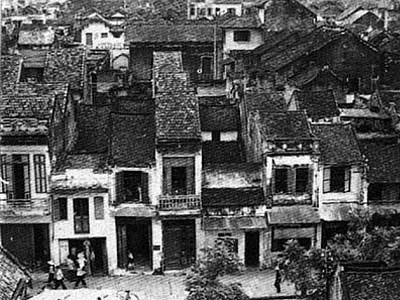One of the reasons that Hanoi – the capital city of Vietnam, has attracted so many tourists over the years is its Old Quarter (36 old streets and guilds). It is an area well-known for the history, the architecture, the enormous amount and diversity of products and even the everyday life of its residents.

Hanoi Old Quarter
The Old Quarter marked its appearance in the 11th century when King Ly Thai To decided to build his palace. That means By 2010, Hanoi, as well as the 36 old streets, turned 1000 years old. Originally a group of workshop villages surrounding the royal palace, the Old Quarter has gradually transformed into craft cooperatives, or guilds and soon gained its reputation as the business trading areas of the Red River delta.
Skilled craftsmen migrated to the Quarter to live and work together in the same guilds, which were made specialized for artisans performing similar services. The new allocation of production and service helped to create a cooperative system for merchandise transportation to designated streets. Soon under French colony, the Old Quarter increasingly became a marketplace for trade between the local and businessmen from China, India, and France.
Despite the damages that Vietnam War left in Hanoi, the Old Quarter still retained much of the original traits that interest tourists, especially those with architectural passion. These houses are neither tall buildings as people normally see in cities nor stilt houses on lines of poles, which were popular in Vietnams’ mountainous regions these days. They are also called “tubular houses” which are short and narrow but have great length.
In the past, the king stipulated that “citizens’ houses could not be built higher than the height of the king’s palanquin”. And because of the dense population in a limited area, people needed to spend the front room for stores; the inside room is widened to its length in order to divide places for manufacturing, dining, and living of each family.
The house is sometimes too narrow that only one person can pass by at a time. Standing close together, these tubular houses make up the ward along the soil streets; some streets were paved with stone or brick. Only until the later time, they were asphalted.
Hanoi Old Quarter
Visitors will certainly be eager to wander along the old streets to drop by stores and buy specialties. Here is an essential guide for tourists who would like to explore the Old Quarter, with some names of specialized streets: China bowls (Bat Su), roasted fish (Cha Ca), silver or jewelries (Hang Bac), women accessories (Cau Go), shoes and sandals (Hang Dau), silk (Hang Gai), mixed fruits (To Tich), combs (Hang Luoc), jars (Hang Chinh), tour services (Ma May), candies and dry apricot (Hang Duong), fried/roasted sour pork hash (Tam Thuong lane on Hang Bong Street), bamboo products (Hang Buom), etc.
In addition, visitors, as well as city dwellers, can go to the night market taking place along 4 walking old streets: Hang Dao – Hang Ngang – Hang Duong – Dong Xuan in the evening from Friday to Sunday with products on great sale. Read our article on Most Special Streets of Hanoi Old Quarter for more ideas.
Hanoi Old Quarter
Hanoi Old Quarter is about 45 minutes away from Noi Bai International Airport and 15 minutes from Hanoi Train Station. Most hotels are located in or near the Old Quarter so you can easily walk to these streets without much effort.
Near the Old Quarter, hotels are plentiful. Our suggestions:
Hanoi Sofitel Metropole rooms start at $315 per night.
Hanoi Hilton Opera rooms start at $169 per night.
Serenade Hotel rooms start at $88 per night.
This post was last modified on November 28, 2018 9:10 am
Discover Vietnam is not only about discovering the landscape but also about discovering culture. One of the outstanding Vietnamese cultures…
On the theme of Vietnam's spiritual travel, in our country's culture, spirituality occupies a prominent place, playing a crucial role…
Embark on an eco-tour to Vietnam and discover renowned ancient villages. Immerse yourself in the rich culture and sustainable practices…
Da Lat has long attracted tourists with its romanticism tinged with mystery. Besides the fresh air and stunning natural landscapes,…
Phong Nha - Ke Bang National Park, a UNESCO World Heritage Site, is a fantastic place to visit for those…
Traveling to Vietnam isn't just about immersing yourself in natural beauty; it's also a golfer's paradise, offering unparalleled experiences on…
This website uses cookies.